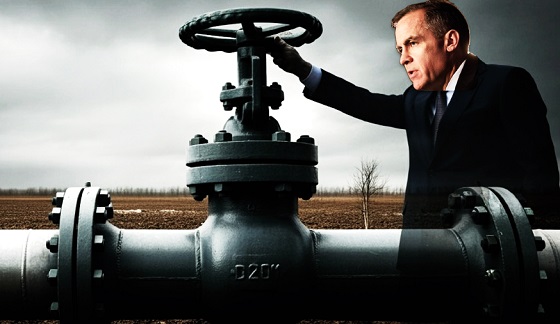C2C Journal
Parks Canada Tries to Cancel Sir John A. Macdonald in his Own Home

From the C2C Journal
By Greg Piasetzki
“You can’t go home again,” American novelist Thomas Wolfe once wrote. Should the same advice apply to the home of Canada’s most important political personality? Greg Piasetzki first visited Bellevue House, one-time Kingston abode of Canada’s founding father Sir John A. Macdonald, when he was a university student in the 1970s. Now, following a controversial renovation of the site by Parks Canada that aims to tell “broader, more inclusive stories about Canada’s first prime minister” – a makeover that includes signs denouncing Macdonald as “a monster” in his own home – Piasetzki returns to Bellevue House to take the measure of the changes.
C2C Journal
Canada Desperately Needs a Baby Bump

The 21 st century is going to be overshadowed by a crisis that human beings have never faced before. I don’t mean war, pestilence, famine or climate change. Those are perennial troubles. Yes, even climate change, despite the hype, is nothing new as anyone who’s heard of the Roman Warm Period, the Mediaeval Warm Period or the Little Ice Age will know. Climate change and the others are certainly problems, but they aren’t new.
But the crisis that’s coming is new.
The global decline in fertility rates has grown so severe that some demographers now talk about “peak humanity” – a looming maximum from which the world’s population will begin to rapidly decline. Though the doomsayers who preach the dangers of overpopulation may think that’s a good development, it is in fact a grave concern.
In the Canadian context, it is doubly worrisome. Our birth rates have been falling steadily since 1959. It was shortly after that in the 1960s when we began to build a massive welfare state, and we did so despite a shrinking domestically-born population and the prospect of an ever-smaller pool of taxable workers to pay for the expanding social programs.
Immigration came to the rescue, and we became adept at recruiting a surplus population of young, skilled, economically focused migrants seeking their fortune abroad. The many newcomers meant a growing population and with it a larger tax base.
But what would happen if Canada could no longer depend on a steady influx of newcomers? The short answer is that our population would shrink, and our welfare state would come under intolerable strain. The long answer is that Canadian businesses, which have become addicted to abundant, cheap foreign labour through the Temporary Foreign Worker Program, would be obliged to invest in hiring, training and retaining Canadian workers.
Provincial and federal governments would scramble to keep older Canadians in the workforce for longer. And governments would be torn between demands to cut the welfare state or privatize large parts of it while raising taxes to help pay for it.
No matter what, the status quo won’t continue. And – even though Canada is right now taking in record numbers of new immigrants and temporary workers – we are going to discover this soon. The main cause is the “peak humanity” that I mentioned before. Fertility rates are falling rapidly nearly everywhere. In the industrialized West, births have fallen further in some places than in others, but all countries are now below replacement levels
(except Israel, which was at 2.9 in 2020).
Deaths have long been outpacing births in China, Japan and some Western countries like Italy. A recent study in The Lancet expects that by 2100, 97 percent of countries will be shrinking. Only Western and Eastern sub-Saharan Africa will have birth rates above replacement levels, though births will be falling in those regions also.
In a world of sub-replacement fertility, there will still be well-educated, highly skilled people abroad. But there will not be a surplus of them. Some may still be ready and willing to put down roots in Canada, but the number will soon be both small and dwindling. And it seems likely that countries which have produced Canada’s immigrants in recent years will try hard to retain domestic talent as their own populations decline. In contrast, the population of sub-Saharan Africa will be growing for a little longer. But unless education and skills-training change drastically in that region, countries there will not produce the kind of skilled immigrants that Canada has come to rely on.
And so the moment is rapidly approaching when immigration will no longer be able to make up for falling Canadian fertility. Governments will have to confront the problem directly—not years or decades hence, but now.
While many will cite keeping the welfare state solvent as the driving force, in my view this is not the reason to do it. The reason to do it is that it is in Canada’s national interest to make it easier for families to have the number of children that they want. A 2023 study by the think-tank Cardus found that nearly half of Canadian women at the end of their reproductive years had fewer children than they had wanted. This amounted to an average
of 0.5 fewer children per woman – a shortfall that would lift Canada close to replacement level.
The United Nations Population Fund (UNPF) has noticed the same challenge on a global scale. Neither Cardus nor the UNPF prescribes any specific solutions, but their analysis points to the same thing: public policy should focus on identifying and removing barriers families face to having the number of children they want.
Every future government should be vigilant against impediments to family-formation and raising a desired number of children. Making housing more abundant and affordable would surely be a good beginning. Better planning must go into making livable communities (not merely atomized dwellings) with infrastructure favouring families and designed to ease commuting. But more fundamentally, policy-makers will need to ask and answer an uncomfortable question: why did we allow barriers to fertility to arise in the first place?
The original, full-length version of this article was recently published in C2C Journal.
Michael Bonner is a political consultant with Atlas Strategic Advisors, LLC, contributing editor to the Dorchester Review, and author of In Defense of Civilization: How Our Past Can Renew Our Present.
Business
Carney’s Energy Mirage: Why the Prospects of Economic Recovery Remain Bleak

 By Gwyn Morgan
By Gwyn Morgan
Gwyn Morgan argues that Mark Carney, despite his polished image and rhetorical shift on energy, remains ideologically aligned with the Trudeau-era net-zero agenda that stifled Canada’s energy sector and economic growth. Morgan contends that without removing emissions caps and embracing real infrastructure investment, Canada’s recovery will remain a mirage — not a reality.
Pete Townshend’s famous lyrics, “Meet the new boss / Same as the old boss,” aptly describe Canada’s new prime minister. Touted as a fresh start after the Justin Trudeau years, Mark Carney has promised to turn Canada into a “clean and conventional energy superpower.” But despite the lovey-dovey atmosphere at Carney’s recent meeting with Canada’s premiers, Canadians should not be fooled. His sudden apparent openness to new energy pipelines masks a deeper continuity, in my opinion: Carney remains just as ideologically committed to net-zero emissions.
Carney’s carefully choreographed scrapping of the consumer carbon tax before April’s election helped reduce gasoline prices and burnished his centrist image. In fact, he simply moved Canada’s carbon taxes “upstream”, onto manufacturers and producers, where they can’t be seen by voters. Those taxes will, of course, be largely passed back onto consumers in the form of higher prices for virtually everything. Many consumers will blame “greedy” businesses rather than the real villain, even as more and more Canadian companies and projects are rendered uncompetitive, leading to further reductions in capital investment, closing of beleaguered factories and facilities, and lost jobs.
This sleight-of-hand is hardly surprising. Carney spent years abroad in a career combining finance and eco-zealotry, co-founding the Glasgow Financial Alliance for Net Zero (GFANZ) and serving as the UN’s Special Envoy for Climate Action and Finance. Both roles centred on pressuring institutions to stop investing in carbon-intensive industries – foremost among them oil and natural gas. Now, he speaks vaguely of boosting energy production while pledging to maintain Trudeau’s oil and natural gas emissions cap – a contradiction that renders new pipeline capacity moot.
Canada doesn’t need a rhetorical energy superpower. It needs real growth. Our economy has just endured a lost decade of sluggish overall growth sustained mainly by a surging population, declining per-capita GDP and a doubling of the national debt. A genuine recovery requires the kind of private-sector capital investment and energy infrastructure that Trudeau suppressed. That means lifting the emissions cap, clearing regulatory bottlenecks and building pipelines that connect our resources to global markets.
We can’t afford not to do this. The oil and natural gas industry’s “extraction” activities contribute $70 billion annually to Canada’s GDP; surrounding value-added activities add tens of billions more. The industry generates $35 billion in annual royalties and supports 900,000 direct and indirect jobs. Oil and natural gas also form the backbone of Canada’s export economy, representing nearly $140 billion per year, or about 20 percent of our balance of trade.
Yet Quebec still imports oil from Algeria, Saudi Arabia and Nigeria because Ottawa won’t push for a pipeline connecting western Canada’s producing fields to Quebec and the Maritimes. Reviving the cancelled Energy East pipeline would overcome this absurdity and give Canadian crude access to European consuming markets.
Carney has hinted at supporting such a project but refuses to address the elephant in the room: without scrapping the emissions cap, there won’t be enough production growth to justify new infrastructure. So pipeline CEOs shouldn’t start ordering steel pipe or lining up construction crews just yet.
I continue to believe that Carney remains beholden to the same global green orthodoxy that inspired Trudeau’s decade of economic sabotage. While the United States shifts course on climate policy, pulling out of the Paris Accord, abandoning EV mandates and even investigating GFANZ itself, Canada is led by a man at the centre of those systems. Carney’s internationalist career and personal life – complete with multiple citizenships and a spouse known for environmental activism – underscore how far removed he is from ordinary Canadians.
Carney’s version of “clean energy” also reveals his bias. Despite the fact that 82 percent of Canada’s electricity already comes from non-greenhouse-gas-emitting sources like hydro and nuclear, Carney seems fixated on wind and solar-generated power. These options are less reliable and more expensive – though more ideologically fashionable. To climate zealots, not all zero-emission energy is created equal.
Even now, after all the damage that’s been done, Canada has the potential to resume a path to prosperity. We are blessed with vast natural resources and skilled workers. But no economy can thrive under perpetual policy uncertainty, regulatory obstruction and ideological hostility to its core industries. Energy projects worth an estimated $500 billion were blocked during the Trudeau years. That capital won’t return unless there is clarity and confidence in the government’s direction.
Some optimists argue that Carney is ultimately a political opportunist who may shift pragmatically to boost the economy. But those of us who have seen this movie before are sceptical. During my time as a CEO in the oil and natural gas sector, I witnessed Justin’s father Pierre Trudeau try to dismantle our industry under the guise of progress. Carney, despite or perhaps because of his polish, may be the most dangerous of the three.
The original, full-length version of this article was recently published in C2C Journal.
Gwyn Morgan is a retired business leader who was a director of five global corporations.
-

 MAiD2 days ago
MAiD2 days agoCanada’s euthanasia regime is already killing the disabled. It’s about to get worse
-

 Daily Caller15 hours ago
Daily Caller15 hours agoUSAID Quietly Sent Thousands Of Viruses To Chinese Military-Linked Biolab
-

 Alberta11 hours ago
Alberta11 hours ago‘Far too serious for such uninformed, careless journalism’: Complaint filed against Globe and Mail article challenging Alberta’s gender surgery law
-

 Censorship Industrial Complex22 hours ago
Censorship Industrial Complex22 hours agoCanadian pro-freedom group sounds alarm over Liberal plans to revive internet censorship bill
-

 Fraser Institute1 day ago
Fraser Institute1 day agoBefore Trudeau average annual immigration was 617,800. Under Trudeau number skyrocketted to 1.4 million from 2016 to 2024
-

 Daily Caller2 days ago
Daily Caller2 days ago‘I Know How These People Operate’: Fmr CIA Officer Calls BS On FBI’s New Epstein Intel
-

 International2 days ago
International2 days agoChicago suburb purchases childhood home of Pope Leo XIV
-

 Economy1 day ago
Economy1 day agoThe stars are aligning for a new pipeline to the West Coast
 Bellevue House was the Kingston, Ontario home of Sir John A. Macdonald, Canada’s first prime minister, (top left) and his wife Isabella (top right) in the 1840s; it was later purchased by the federal government ahead of Canada’s 1967 Centennial and designated a National Historic Site in 1995. At bottom, the house circa 1891. (Source of bottom photo:
Bellevue House was the Kingston, Ontario home of Sir John A. Macdonald, Canada’s first prime minister, (top left) and his wife Isabella (top right) in the 1840s; it was later purchased by the federal government ahead of Canada’s 1967 Centennial and designated a National Historic Site in 1995. At bottom, the house circa 1891. (Source of bottom photo:  “Extensive renewal”: Bellevue House was closed in 2017 due to its deteriorating condition; Parks Canada re-opened it to the public in May 2024 following a comprehensive modernization project. Shown, Bellevue House undergoing repairs in 2020. (Source of photo:
“Extensive renewal”: Bellevue House was closed in 2017 due to its deteriorating condition; Parks Canada re-opened it to the public in May 2024 following a comprehensive modernization project. Shown, Bellevue House undergoing repairs in 2020. (Source of photo:  This old house looks great: The renovations of Bellevue House have transformed the structure into a beautiful representation of upper-class living in pre-Confederation Canada. Clockwise from top left: the visitor centre, Parks Canada staff in period garb, the dining room and the parlour. (Sources of photos: (top and bottom left)
This old house looks great: The renovations of Bellevue House have transformed the structure into a beautiful representation of upper-class living in pre-Confederation Canada. Clockwise from top left: the visitor centre, Parks Canada staff in period garb, the dining room and the parlour. (Sources of photos: (top and bottom left)  The bad news: In keeping with the Justin Trudeau government’s apparent mission to denigrate and erase important figures from Canada’s colonial history, a sign on the path to Bellevue House claims Macdonald was a “monster”. (Source of photo:
The bad news: In keeping with the Justin Trudeau government’s apparent mission to denigrate and erase important figures from Canada’s colonial history, a sign on the path to Bellevue House claims Macdonald was a “monster”. (Source of photo:  Repeat after me, colonialism, genocide and racism: Bellevue House is incongruously filled with numerous Indigenous artifacts and informational displays that attack or undermine Macdonald’s many great accomplishments. (Source of photo:
Repeat after me, colonialism, genocide and racism: Bellevue House is incongruously filled with numerous Indigenous artifacts and informational displays that attack or undermine Macdonald’s many great accomplishments. (Source of photo:  Controlling the narrative: Rodrick Donald Maracle, Chief of the Mohawks of the Bay of Quinte, used the re-opening ceremonies at Bellevue House to declare that “Macdonald supported oppression of Indigenous Peoples’ identity.”
Controlling the narrative: Rodrick Donald Maracle, Chief of the Mohawks of the Bay of Quinte, used the re-opening ceremonies at Bellevue House to declare that “Macdonald supported oppression of Indigenous Peoples’ identity.” Despite the surfeit of Indigenous content in Bellevue House, there is no mention of Macdonald’s friendship with several prominent aboriginal Canadians, including Oronhyatekha, aka Burning Cloud (left) and Kahkewaquonaby, aka Peter Jones (right). Both earned university degrees (Oronhyatekha also attended a residential school) and played significant roles in Macdonald’s political campaigns.
Despite the surfeit of Indigenous content in Bellevue House, there is no mention of Macdonald’s friendship with several prominent aboriginal Canadians, including Oronhyatekha, aka Burning Cloud (left) and Kahkewaquonaby, aka Peter Jones (right). Both earned university degrees (Oronhyatekha also attended a residential school) and played significant roles in Macdonald’s political campaigns. For all time: Macdonald’s significance as Canada’s pre-eminent statesman is what draws visitors to Bellevue House. And this record of achievement is sturdy enough to survive any attempt to cancel him, even by the current federal government. Shown, Macdonald, standing at centre, in Robert Harris’ famous painting Fathers of Confederation, circa 1884.
For all time: Macdonald’s significance as Canada’s pre-eminent statesman is what draws visitors to Bellevue House. And this record of achievement is sturdy enough to survive any attempt to cancel him, even by the current federal government. Shown, Macdonald, standing at centre, in Robert Harris’ famous painting Fathers of Confederation, circa 1884. 
